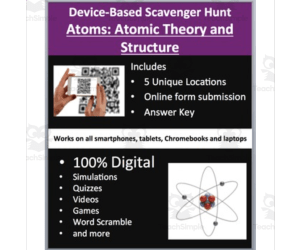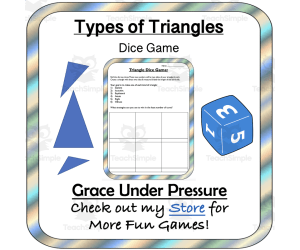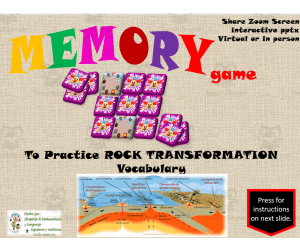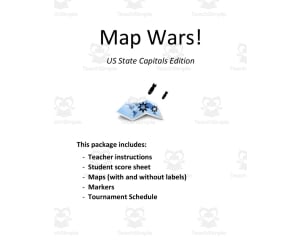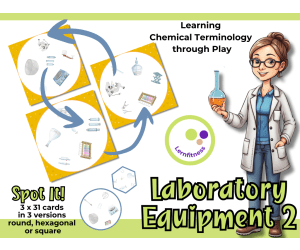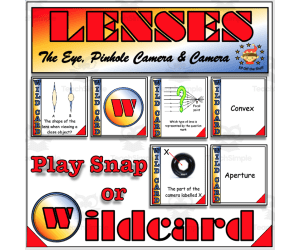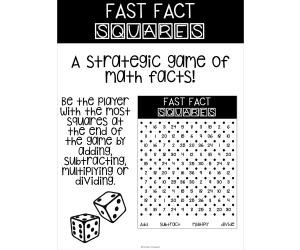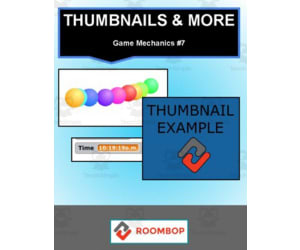6,394 products added recently
Page 4 - 7th Grade Games
Bring energy to your seventh-grade classroom with games that align with learning goals. This collection includes strategy challenges, language arts activities, and mathematical explorations. By incorporating these games into your lessons, you can make learning more engaging and effective.
Country Study on South Korea - Guess Who Game Cards on Famous Koreans
Social Studies, Geography, History, History: Asian, Grade 6, 7, 8, 9, 10, 11, 12, Activities, Games
Country Study on South Korea - Guess Who Game Cards on Famous Koreans This Teaching Resource is a fun Guess Who Game PDF (1 slide, 15 cards) on Famous Korean People. This Printable Resource can be great for Geography, Asian History and Social Studies Classes. Suitable Learners for this kind of lesson are students from 6th Grade to 12th Grade. This Geography + Social Studies Guess Who Game on Famous People from South Korea (Country Study) aims to introduce learners to South Korea and its most famous Koreans (leaders, film makers, politicians, music groups, singers etc.). Little Preparation is needed for this Social Studies + Geography Activity. Some of the Korean People selected for this Geography + Social Studies + Asian History Country Study on South Korea are: Sejong the Great (Monarch and creator of Korean Writing System Hangul) Kim Dae-jun (President of South Korea) BTS (K-Pop Boy Band) Blackpink (K-Pop Band) BoA (Singer) June Huh (Mathematician) Bong Joon-ho (Academy Award Film Maker; "Parasite") Ban Ki-moon (UN Secretary-General and Politician) Queen Min (Korean Monarch) and many more! A very fun and engaging way to play this "Guess Who on Famous People from South Korea" (country study on South Korea) game can be the following: all Learners sit on the floor in a circle every Learner has a Flash Card on their face every Learner/player asks a question about their Flash Card 's famous Korean This Social Studies + Geography Country Study on South Korea PDF Printable Teaching Resource (1 slide, 15 cards for 15 Famous People from Korea) can be great for learners from 6th grade to 12th grade to introduce South Korea and its Culture through its most important and celebrated people. Learning with Alan is a Brand New Teaching Resource/Educational Material Store whose aim is to help Teachers, Educators and Tutors to achieve their teaching objectives while creating a fun and stimulating environment. Never Forget! If you want to browse more of my Teaching Resources, click here Learning with Alan!
Author Learning with Alan
Tags South Korea, Asia, Famous People, Geography, Social Studies, Country Study, Guess Who, Cards, Game, Printable
Atoms: Atomic Theory and Structure - Device-Based Scavenger Hunt Activity
Science, Chemistry, Grade 7, 8, 9, 10, 11, Activities, Games
Atoms: Atomic Theory and Structure - Device-Based Scavenger Hunt Activity. This activity is the coolest thing I've created and your kids are going to love it, mine do. Think of a scavenger hunt, then add devices (Smartphones, Chromebooks, Laptops, or Tablets), engaged students, and learning through assessment and you have this resource. ********************* Quick Disclaimer. In order to use this activity, your classroom must have at least 1 device per 3 students. Smartphones, Chromebooks, Laptops, and Tablets will all work perfectly. The Content Includes: • Atomic Theory --> Contributing scientists --> Historical theories • Atomic Structure --> Protons --> Neutrons --> Electrons --> Particle location and charge • Atoms visualization and application Here's how you implement them: • Print the QR codes and place them around the room • Place your students into groups • Let them loose! They move from Location to Location as they complete their tasks. Each Task is assigned by scanning the QR code and there are 5 Tasks per Scavenger Hunt Activity. • Have them submit their answers directly to your email via a form on my website. ********************************************************************** I've created a video that walks you through the entire activity. I did it using screen capture software on my phone so you can see exactly what your students will see. CLICK HERE to have a look . ********************************************************************** This activity: • Lets your students utilize their devices • Cuts down on wasted paper • Combines learning with assessment • Is a lot of fun • Comes in both Word and PDF formats Each Hunt is different and offers a unique way for your students to explore the topic. From Hunt-to-Hunt, possible tasks your students will face include: • Video analysis • Simulations • Fully automated and marked Quiz • Finish the story • Start the story • Calculations • News article • Opinion • Word scramble • Short answer • Web research Buyer Comment: "Really fun activity for high school being all students have a phone" --------------------------------------------------------------------------------------------- There are other Hunts as well and I'm continually adding more. Currently, the Hunts I have available include: Biology: • Cell Organelles • The Digestive System • The Circulatory System • Biochemistry - Macromolecules • Photosynthesis and Cellular Respiration • Mitosis and Cell Division • Cells and the Cell Theory – A Device-Based Scavenger Hunt Activity Ecology: • Energy Flow in Ecosystems • Invasive Species • Photosynthesis and Cellular Respiration • Cycling of Matter in Ecosystems • Ecosystems and Ecological Succession Space and Earth Science: • The Seasons • Our Solar System • The Moon • The International Space Station - Meeting Our Needs • Climate Change Electricity: • Static Electricity • Electricity Generation Chemistry: • Atoms: Atomic Theory and Structure • Physical and Chemical Changes • Elements and the Periodic Table • Chemical Reactions • Types of Chemical Reactions and Balancing • Acids, Bases and pH Physics: • Friction • Energy Transfer --------------------------------------------------------------------------------------------- Also, please visit my website Teach With Fergy for my thoughts on teaching, learning and everything in between.
Author Teach With Fergy
Tags Atomic Theory Assessment, Atoms Printable, Chemistry Scavenger Hunt, Digital Scavenger Hunt, Science Games, Atomic Theory Activity
Diverse Media Digital Game
ELA, Strategies, Grade 6, 7, 8, Activities, Games
This is a Diverse Media Digital Game. Directions are included for how to prep and implement this game. All part of this game are self-checking.
Author Mrs. Spangler in the Middle
Tags Media Literacy, Diverse Media, Google Classroom, Text Evidence, Digital Game
White Light, Dispersion and Colour Filters Find the Pair Game for Middle School
Science, Physics, Grade 5, 6, 7, 8, 9, Activities, Games
White Light, Dispersion, and Colour Filters Find the Pair Game for Middle School An interactive learning solution designed for grade 5 to grade 9 students tasked with grasping light's physical properties under their Physics study sub-category. It makes teaching about White Light, Dispersion, and Colour Filters both enjoyable and memorable. The Gameplay The game involves teams of three to four students each engaging in a memory challenge based on the principles of white light, dispersion, and color filters. The objective is to lay out 42 question-and-answer cards face down in a square formation. Each player's turn involves flipping two cards with the hope they complete a correct question-and-answer pair. Game Mechanics If successful at matching a Q&A pair: Secure it. If not successful: Flip cards back over before the next student's turn. A level of challenge is introduced through reference books or teacher consultation using special answer sheets. Key Knowledge Requirements: An understanding of spectrum color order, A grasp of dispersion that transforms white light into seven spectrum colors, An idea about speed variation among different light colors as they pass through glass, An ability to identify primary (red/green/blue) & secondary (magenta/cyan/yellow) light colors, and understand how they interact; A comprehension on why objects reflect certain colours versus others absorbed; .li Instructors’ Preparation Guide: List bullets: Prepare by printing a double-sided set for each group – the sets can be laminated for extended reusability; Cut the printed pages into separate cards and it's ready to play! Note: This product can be used class-wide or assigned as homework. Share your feedback on this tool to help improve its capabilities and earn credit towards future purchases. This product is downloadable through Elf Off the Shelf Resources in Multiple File Types, though materials are not included in this package.
Author Elf off the Shelf Resources
Tags Light Properties, Color Dispersion, Color Filters, Interactive Learning, Middle School Science
Triangle Dice Game: Isosceles, Scalene, Equilateral, Right, Acute, Obtuse
Math, Geometry, Measurements, Grade 4, 5, 6, 7, Activities, Games
Here's a deceptively simple dice game to practice identifying and creating six kinds of triangles. Three are classified by their angles: acute, right, and obtuse. Three are classified by their side lengths: scalene, equilateral, and isosceles. Use this game to reinforce the definitions of each of these six triangles in a geometry/measurement unit. Students work independently or in small groups. Each player needs two dice. They roll them and use the two numbers as side lengths in centimetres for a triangle. They draw the triangle in one of the boxes on their paper and measure and label the third side length. Here's where the strategy and critical thinking come in. Can students make six kinds of triangles in less than six turns? Maybe! If they get some lucky rolls! For example, if a student gets a roll with two of the same numbers, they should make an isosceles or equilateral triangle (depending on what angles they draw). But this triangle will also be an acute triangle (or an isosceles right triangle). Clever students (with lucky rolls) should be able to complete the task in less than six turns. Standards: CCSS 4.G.A.2 Classify two-dimensional figures based on the presence or absence of parallel or perpendicular lines, or the presence or absence of angles of a specified size. Recognize right triangles as a category, and identify right triangles. CCSS 7.G.A.2 Draw (freehand, with ruler and protractor, and with technology) geometric shapes with given conditions. Focus on constructing triangles from three measures of angles or sides, noticing when the conditions determine a unique triangle, more than one triangle, or no triangle. Grades: This game works well in classes from grades 4-7. Ideally students know how to use a ruler and a protractor. If you enjoy this product, check out the other math games in my store Grace Under Pressure
Author Grace Under Pressure
Tags Triangles, Geometry, Isosceles, Obtuse, Acute, Right Triangle, Scalene, Math Game, Dice Game, Hands-on Math, Triangle Scalene Isosceles Equilateral, Isosceles Scalene And Equilateral Triangles, Scalene Isosceles And Equilateral Triangles, Scalene Isosceles Equilateral, Isosceles Scalene, Obtuse Isoceles, Equilateral Acute, Acute Equilateral, Isoceles Obtuse, Isosceles Scalene Equilateral, Classify Triangles Game, Obtuse Equilateral
Winter Solving Proportions Pixel Art and Printable Task Cards
Math, Algebra, Grade 6, 7, 8, Activities, Games, Worksheets & Printables, Task Cards
Looking for a creative way to teach solving proportions this winter season? This no-prep, digital pixel art activity with printable task cards is the perfect solution! Designed to captivate your students while reducing your workload, this activity combines seasonal fun with a self-checking system to keep learners engaged as they master proportions. Why Teachers Love It ✅ No Prep Needed: Ready to use—just assign the link and let your students dive in! ✅ Self-Checking: Students receive instant feedback, allowing them to learn independently with minimal teacher intervention. ✅ Motivating Pixel Art: Each correct answer reveals part of a colorful, winter-themed pixel art image. ✅ Flexible & Convenient: Autosave ensures students can pause and pick up exactly where they left off (same device and browser required). What’s Included 1. Digital Pixel Art Activity Interactive, self-checking platform for solving proportions problems. Fill-in-the-blank questions designed to challenge and engage. Autosave feature and a “Continue” button for seamless progress across multiple sessions. 2. Printable Task Cards & Handouts Task cards for hands-on, offline practice that complements the digital activity. Answer key for quick grading and feedback. ❄️ Why Students Will Love It Interactive Gameplay: A fun, seasonal twist to math practice that reveals pixel art as they progress. Instant Feedback: Keeps them on track and motivated to improve. Self-Paced Learning: Builds confidence and reduces stress by allowing independent work. Perfect For Math centers Sub plans Homework assignments Individual or group practice Distance learning How It Works: Students solve proportions on the interactive digital platform. Each correct answer reveals part of a winter-themed pixel art image. Progress is automatically saved, ensuring students can pause and resume as needed. Optional printable task cards and answer keys provide extra practice and flexibility. Elevate your winter math lessons with this engaging, ready-to-go resource. No logins, no extra setup—just seasonal fun and standards-aligned learning. Bring winter magic into your classroom! Order now and watch your students master proportions with ease and excitement.
Author Matemaths
Tags Pixel Art, Interactive Activity, Digital Learning, Matemaths, Winter , Proportions
Storytelling Cards Game - My Travel around Europe for ESL EFL TESOL
Social Studies, ELA, Language Development, ESL, Writing, Creative Writing, Grade 7, 8, 9, 10, 11, 12, Games, Activities
Storytelling Cards Game - My Travel around Europe for ESL EFL TESOL This Printable Teaching Material is great for ESL, EFL Students, mainly High Schoolers/ Middle Schoolers (Teens), Homeschooling Classes or ANY English Second Language School Around the world! This ESL, EFL Game is great to improve English as a Second Language Vocabulary and Speaking skills. This Teaching Resources can be employed by ESL, EFL Centers Abroad and TESOL TEFL Tutors or independent teachers, educators around the globe (online or offline). This ESL, EFL, TESOL Resource offers 80 Flashcards with Europe and Travelling Vocabulary + Sights (an airport, the Big Ben, Kyiv, the Colosseum, Vienna, Polish Pierogi, a pirate ship, a suitcase, a passport, Budapest, Cracow, Hamburg Opera House etc. …). These English as a Second or Foreign Language Storytelling Flashcards can be shuffled so students can pick their Flashcards to tell their own unique story. Teachers and Students can use storytelling cards in various ways. My personal advice is to do the following spreads: the MINI STORY: every Learner picks 3 Storytelling Flashcards and tries to create their Europe-themed story the "NEVER ENDING STORY": every student picks by turn a card and given the outcome of the previous fished flashcards, he tries to continue the story's narration These are only TWO of the many spreads ESL Teachers and Learners can come up with! Don't be Shy and use your creativity to teach/learn English! This ESL, EFL, TESOL, TEFL Teaching Resource (80 storytelling Cards on Europe; 10 pages) can be great for Intermediate Advanced English as a second or foreign language learners. Its aim is to make students exercise and/or improve their speaking, storytelling English as a second language Skills. ESL with Alan is a Brand New ESL, EFL, TESOL Store whose aim is to help English as a Second or foreign Language Teachers, Educators and Tutors (be it online or offline) to achieve their teaching objectives while creating a fun and stimulating environment. Never Forget! Learning is fun, So should English! Always If you want to browse more of my PDF ESL, EFL, TESOL Teaching Resources, click here ESL with Alan!
Author Learning with Alan
Tags ESL, EFL, English, Europe, Cards, Flashcards, Activity, Storytelling, Teens
Text Structure Digital Game
ELA, Reading, Grade 6, 7, 8, Games, Activities
This is a Text Structure Digital Game. Directions are included for how to prep and implement this game. All part of this game are self-checking.
Author Mrs. Spangler in the Middle
Tags Digital Game, Text Structure, Point Of View, Reading Strategies, Google Classroom, Text Structure Online Activities
Free Science Interactive Memory Game / Rock Transformation Vocabulary
Science, Earth and Environmental Sciences, Basic Science, Earth Sciences, Environmental Science, Grade 7, Games, Activities
Free Science Interactive Memory Game / Rock Transformation Vocabulary Reinforce seventh-grade science curriculum covering rock transformations with this interactive memory game. Students will learn, practice, and review key vocabulary words and definitions related to rock transformations in an engaging game format. The 17-slide PowerPoint includes visual aids to boost retention and multiple built-in reviews. Use this versatile resource for whole class instruction, small groups, individual practice, or even homework. As students match coordinating image and definition pairs, this activity strengthens memory, concentration, visual recognition, and information processing skills. For more interactive science games and resources, search our store for Spanish math, language arts, reading, and writing materials spanning kindergarten through fifth grade.
Author ShapeUp-N-Matematicas y Lenguaje
Tags Rock Transformation, Igneous Rock, Magma, Plate, Sedimentary Rock, Small Or Whole Group , Interactive Activity, Game, Sediment, Plate Boundary
Integer Card Games
Math, Numbers, Grade 7, Activities, Games
Particularly, with the topic of integers, students REALLY need to be fast and fluent with their facts. Quizzing & drilling constantly is one way to achieve that… however, these games will help break up the monotony and build the solid foundation they will need to be able to keep a good pace with problem solving later on. 1) There are several games to choose from, each a different difficulty & pace. 2) Prepare to take time to explain the rules in detail to make sure students understand how to play. 3) Once students know the rules well, these will be very quick and easy activities any time they need review (constantly), or you need a time filler. Just save/laminate your decks of cards and pull them out when needed! Most games are geared towards fluency in find the sum of two integers, but some can be played by also finding the product of two integers.
Author The Math Cafe
Tags Integers, Card Games, Integer Classroom Games, Integer Games For 7th Grade
Scratch Halloween: Ghost Game
Science, Technology, Computer Science, Grade 3, 4, 5, 6, 7, 8, 9, 10, Games, Activities
Scratch Halloween: Ghost Game is a programming activity that teaches students how to code a spooky video game using Scratch. Students create an interactive game where they catch ghosts with their mouse cursor. The step-by-step tutorial guides learners of all abilities through building core coding concepts like variables, conditionals, events, and more. Educators can implement this resource in many ways - assign it to individuals or small groups for self-paced learning, use it for whole class computer lab instruction, or even flip the classroom by assigning it as pre-learning before a programming lesson. This engaging and seasonal activity is adaptable for elementary through high school students learning coding fundamentals or looking to advance their Scratch skills by designing their own creative variations after completing the tutorial.
Author Roombop
Tags Scratch, Scratch Programming, Coding, Ghost Scratch, Halloween Scratch, Google Halloween Ghost Game
Atoms Bingo Game
Science, Chemistry, Grade 6, 7, 8, Activities, Games
This resource is an Atoms Bingo Game. Atoms and the Periodic Table Bingo will help your students review topics and terms that they have learned throughout their Atoms and the Periodic Table unit . This game is played like any other Bingo game where students must get five in a row to achieve BINGO. The Bingo can be horizontal, vertical, or diagonal. It is recommended that you print and cut out the bingo cards, and then laminate each one for repeated use. Students can then use a dry or wet erase marker to mark the card, allowing for easy clean-up. To play the game, the teacher will read the definition and students must mark the corresponding term on their card. When a students shouts BINGO, make sure you have them read their words out loud so that the correct terms were marked. It is possible that they will think they have a BINGO when they really marked the wrong term. This game could be used to review topics, as a time filler at the end of class, or as sub plans for a guest teacher.
Author Maude in the Middle
Tags Atoms, Bingo Game, Bonding, Periodic Table, Chemistry, Atoms Game, Bingo Periodic Table
Map Wars: U.S. State Capitals Edition | Interactive Geography Game
Social Studies, Geography, Grade 5, 6, 7, 8, Activities, Games
This resource is a Map Wars: U.S. State Capitals Edition Interactive Geography Game. This game is an exciting way for students to apply geography and mapping skills. This is a team game requiring 2 teams that can be played in multiple rounds. Students will love this engaging game! Directions for how to play are included.
Author The Social Studies Doctor
Tags Capitals, Map Wars, Mapping, Team Games, Geography, Interactive States Games
Country Study on Chile Guess Who Game Cards on Famous Chileans
Social Studies, Geography, Grade 6, 7, 8, 9, 10, 11, 12, Activities, Games
Country Study on Chile Guess Who Game Cards on Famous Chileans This Teaching Resource is a fun Guess Who Game PDF (1 slide, 15 cards) on Famous People from Chile. This Printable Resource can be great for Geography and Social Studies Classes. Suitable Learners for this kind of lesson are students from 6th Grade to 12th Grade. This Geography + Social Studies Guess Who Game on Famous Chileans (Country Study) aims to introduce learners to Chile (South America) and its most famous Chileans (leaders, film makers, politicians, writers etc.). Little Preparation is needed for this Social Studies + Geography Activity. Some of the Chilean People selected for this Geography + Social Studies Country Study on Chile are: Bernardo O' Higgins (Chilean Independence Leader) Pablo Neruda (Poet and Novel Literature Prize Laureate) Isabel Allende (Writer) Alejandro Jodorowsky (Film maker) Humberto Maturana (Biologist ang Philosopher) Michelle Bachelet (first Woman President of Chile) Pedro Pascal (Actor) Pablo Larrain (Film Maker) and many more! A very fun and engaging way to play this "Guess Who on Famous People from Chile" (country study on Chile, South America) game can be the following: all Learners sit on the floor in a circle every Learner has a Flash Card on their face every Learner/player asks a question about their Flash Card 's famous Chilean This Social Studies + Geography Country Study on Chile PDF Printable Teaching Resource (1 slide, 15 cards for 15 Famous People from Chile) can be great for learners from 6th grade to 12th grade to introduce Chile and its Culture through its most important and celebrated people. Learning with Alan is a Brand New Teaching Resource/Educational Material Store whose aim is to help Teachers, Educators and Tutors to achieve their teaching objectives while creating a fun and stimulating environment. Never Forget! If you want to browse more of my Teaching Resources, click here Learning with Alan!
Author Learning with Alan
Tags Country Study, Chile, South America, Guess Who, Game, Cards, Social Studies, Geography, Printable, Teaching Resource
Stress Management Game played like Apples To Apples-Handouts
Special Resources, Social Emotional Learning (SEL), Special Education Needs (SEN), Social Skills, Grade 3, 4, 5, 6, 7, Activities, Games
In this fun game, played similarly to the Apples To Apples game, students will read different stressful situations and choose a strategy they would use for that situation. There are 18 situation cards and 36 strategy cards. Each player draws 5 strategy cards (they do not show the other players which cards they have). The "judge" will draw a situation card and show the other players the card after reading the situation. For example, "You don't know the answers when taking a test." Then the other players will choose a strategy card they would use for that situation and place it face down to near the judge. The judge will read the different strategy cards and choose which one they would most likely choose. Important to convey to students: There is no "wrong" strategy, just a strategy that the judge would most likely use. Then for the next round, a different person is the judge and the game continues. the discarded strategy cards can get placed under the strategy pile. the person whose strategy was chosen, gets the situation card and also gets one point. This is a fun and engaging way to get students talking about different strategies they would use for stress management as well as different types of stressful situations they can manage if they need to. In this resource you will also be getting 2 mindful coloring handouts. This is a great way to finish the lesson after the game. I also like to begin this lesson by introducing a Brain Pop on stress. You can also choose a short video of your choice or a book about stress to prime the students' brains about what stress is, possible triggers of stress and how to cope with stress. Then the game can be played and can reinforce the topic.
Author Jennifer Moyer Taylor
Tags Social Emotional Learning, Apples To Apples, Game, Stress Management, Calm, Sel, Social Skills, Anxiety, Special Education, Group Resource
Spot It! – Laboratory Equipment 2 Fun & Engaging Game for Science Lab
STEM, Science, Chemistry, Physics, Life Sciences, Special Education Needs (SEN), Special Resources, Research, Biology, Homeschool Templates, Grade 6, 7, 8, 9, 10, Activities, Games, Worksheets & Printables, Task Cards, Quizzes and Tests, Teacher Tools, Quizzes, Word Problems, Word Searches, Worksheets
Spot It! Laboratory Equipment 2 A Fun & Engaging Game for Science Classrooms 🔬 Make Learning Lab Equipment Fun and Interactive! Teaching students about laboratory equipment doesn’t have to be dull or overwhelming. With Spot It! – Laboratory Equipment, you can turn learning into a fun and engaging experience! This fast-paced matching game is perfect for chemistry, physics, and biology teachers who want to reinforce lab tool recognition in a way that students will love. 🎲 Why This Game Works for Science Teachers ✅ Boosts Visual Memory – Matching images of lab equipment helps students quickly recognize and remember key tools used in science labs. ✅ Encourages Active Participation – Gets students involved instead of passively memorizing lists. ✅ Improves Classroom Engagement – The fast-paced nature of the game keeps students motivated and focused. ✅ Perfect for Any Science Class – Whether you're teaching chemistry, physics, or biology, this game makes learning lab equipment easy and fun. ✅ Promotes Social Interaction – Encourages teamwork, communication, and collaborative learning. 🧪 What’s Included? 🃏 93 Total Cards – You’ll receive three different versions of the game, each with 31 cards: ✔ Round cards – Traditional Spot It! design. ✔ Square cards – Easy to cut and prepare. ✔ Hexagonal cards – Unique design for an extra challenge. 📖 Game Instructions: 1️⃣ Print the cards. 2️⃣ Laminate them for durability (optional). 3️⃣ Cut out the cards in your preferred shape: round, square, or hexagonal. 🎯 How to Play 🃏 Each player receives one card. 🔬 Turn over a card from the stack in the middle. 👀 Find a matching image between your card and the revealed card as quickly as possible. 🏆 If you find a match first, you win the revealed card. 🎉 The player with the most cards at the end wins! This game turns science learning into a competitive, fast-paced, and enjoyable classroom activity that will keep students engaged while reinforcing important lab vocabulary. 📌 Why Teachers Love It ✔ Saves Prep Time – Ready-to-print, simple setup, and no extra materials required. ✔ Great for Small Groups & Whole Class – Use it in science centers, team challenges, or as a warm-up activity. ✔ Adaptable for Different Learning Levels – Suitable for middle school, high school, and even introductory university-level science classes. 🔬 Make Science Learning More Engaging! If you’re looking for a fun, effective, and interactive way to help students learn and remember laboratory equipment, this Spot It! game is the perfect addition to your science classroom. 🚀 Download now and bring hands-on science learning into your classroom today! 📍 Best wishes, Heike from Lernfitness Did You Know? I teach with a certified therapy dog, and together we focus on creating a positive and inspiring learning environment. 🐶✨
Author Lernfitness
Tags Game, Spot It, Educational Card Games, Picture Match, Chemistry, Lab, Biology, Laboratory Equipment, Lab Tools, Physics
Multiplying & Dividing Integers Playing Cards (Games)
Math, Numbers, Grade 7, Activities, Games
The purpose of this set of cards is to build fluency when determining the correct sign of the evaluated expression. The expressions are simple so that computation hinders the pace of the games as little as possible.
Author The Math Cafe
Tags Multiplying & Dividing, Integers, Playing Cards, Games
Bingo Games #2: 7th Grade Math Review
, Grade 7, Activities, Games
This is a PowerPoint Presentation with 2 bingo games for 7th grade math review. Threre are two bingo games with 8 questions each. Topics covered are: probability, similar triangles, predictions from graphs, multi-step word problems, proportional word problems, distributive property with fractions and decimals, box and whisker plots, percents of rations, mean for a set of data, word problems with negative numbers, order of operations with fractions and decimals Directions for BINGO. Have students to make a 4 x 4 game board. They will fill in the answers in random order. This way everyone has a different board but all of the answers. Put up the first 2 questions. When all students finish #1, you can change to the second page, which still has #2 but also #3 for those that have also finished #2. This allows some students to work ahead when ready. When everyone has finished #2, move to the next screen, which has #3 and #4 as some students will be ready for #4. Continue in this way. Students should put a mark in the corner of the square for answers---Don’t have them completely mark out their answers in the first game because they will use this same board in the second game. Students MUST show their work on paper to get credit for a BINGO. For the problems that don’t have work to show, they must explain their answer on paper. The first game uses questions #1-8. In a regular size class there should be 5-6 bingos after this many questions. You can start the second game #9-10 or save that for another class time. Just make sure students save their board because both games use the same board. I like to give a piece of candy (like jolly rancher) for BINGOs. I always help students with their problems since I used BINGO as practice not as an assessment.
Author Math Resources With Rigor
Tags 7th Grade Math Review, Bingo Games
English months, days, and seasons game - I have...Who has?
ELA, Language Development, ESL, Grade 1, 2, 3, 4, 5, 6, 7, 8, Games, Activities
The English months, days, and seasons game - I have...Who has? This is a unique educational resource aimed at enhancing students' understanding and recognition of the months, days, and seasons in the English language. It offers an easy-to-use learning tool ideal for students between 1st to 8th grade. What's Included? The resource includes a total of 27 cards that can either be handled by individual students or shared among pairs depending on your class size or group. To make them last longer, you could consider printing and laminating these cards for reuse. How Does It Work? The principle behind this game is simple but effective. The journey starts with a card marked 'I'll start the game'. A typical example would be something like 'I have May,' followed by 'Who has Autumn?' The student who has the 'Autumn' card responds appropriately by throwing in their own question like ‘Who has Thursday?’ This back-and-forth continues until all cards are used up, ending with the statement ‘The Game is over!’ Note: For more engaging sessions, divide your class under two teams each armed with a set of these cards. Make it competitive; whoever finishes first wins! Where Can It Be Used? This game isn't confined only to ESL (English as Second Language) classrooms; it fits right into any environment where English is the main spoken language – making it universal! Encourage discussions among learners both within diverse classroom settings or homeschooling environments. Life made simple with essential knowledge just one card away!.
Author Love Learning Languages
Tags Months, Days, Seasons, Interactive Learning, Vocabulary Acquisition
Light - Lenses, the Eye, the Pinhole camera and the Camera - Wildcard and Snap Card Games for Middle School
Science, Physics, Grade 5, 6, 7, 8, 9, Games, Activities
Light - Lenses, the Eye, the Pinhole camera and the Camera - Wildcard and Snap Card Games for Middle School: A Must-Have Educational Resource Designed for students in grades 5-9, this engaging teaching resource offers a unique approach to hands-on learning about optics. This comprehensive card deck covers topics that range from Lenses to Eye Anatomy, from Pinhole Cameras to Camera Technology. The pack includes: 66 Educative Playing Cards with scientific facts and diagrams related predominantly to physics. A systematic covering of facts around convex lenses used in various optical devices; how concave lenses work; visual perception through image formation by the eye lens; light regulation by iris-pupil dynamics etc.; this set is a versatile teaching aid. An exploration into interrelated topics such as how glasses correct sight abnormalities using various types of lenses based on individual need and ray diagrams ' working mechanism as it pertains specifically to distant & close object view recognition. The game set has been designed with a 'Wildcard' game apart from basic 'Snap' cards providing an interactive learning experience. The inclusion of an Animated PowerPoint that guides participants through game rules ensures smooth gameplay. Additionale Features: In-depth comparison between a camera’s functioning mechanism versus human vision enables learners to understand real-world applications. Suitable for cooperative education modules such as group activities as well is useful for individual self-study too! Homeschooling parents will find this multi-subject resource highly beneficial. In conclusion:, "Light - Lenses, the Eye, the Pinhole camera and the Camera" effectively makes abstract scientific theories tangible via gamified education while promoting holistic science learning.
Author Elf off the Shelf Resources
Tags Optics, Lenses, Eye Anatomy, Pinhole Camera, Camera Technology
Vocabulary Review Game- Calendar Words I Have, Who Has, Editable
Life Studies, ELA, Language Development, Pre-Reading, ESL, Vocabulary, Grade 1, 2, 3, 4, 5, 6, 7, 8, 9, 10, 11, 12, Activities, Games
Vocabulary Review Game - Calendar Words: I Have, Who Has, Editable An enjoyable and effective teaching resource designed to enhance calendar -related vocabulary and reading fluency in a fun way. Ideal for grades 1-5, but because of its versatile nature it's also suitable for ESOL learners of all ages. Key Features: 24 pre-loaded vocabulary words related to the calendar . Easy-to-follow game that involves reading questions aloud (Who has...?) and responding (I have...). The addition of editable slides where you can insert your own choice of words and images. How Does It Work? The game is played by distributing cards amongst players who then read their question aloud. The holder of the corresponding card responds before asking their own question. The game finishes when it reaches the first student's response. Bonus: Included in this package are QR coded links that direct you to Google Slides presentations, providing each word with realistic photo visuals — useful visual aids particularly beneficial for visual learners. Purpose & Core Objective: Vocabulary Review Game - Calendar Words I Have, Who Has, Editable aims at enhancing students' understanding and usage of school-related words as they formulate complete sentences using specific terms on their given cards. By connecting real-world meanings through personal experiences with respective visual aids provided on each card ensures effective long-term retention! This activity can be used as a warm-up or wrap-up session; it's adaptable enough for diverse learner profiles including ELLs (English Language Learners) and SPED (Special Education) students. Fostering classroom unity while encouraging joint learning experiences- a fun challenge every learner will appreciate!. Download Specifications: The Vocabulary Review Game download is provided as an editable 8-slide PPTX file. It's adaptable for you to insert custom terms and images differing from the original set of 24 vocabulary words. To more easily share with students in a virtual classroom, it can be readily converted into Google Slides format!
Author Melissa Is Teaching
Tags Vocabulary Review, Calendar Words, Learning Game, Reading Fluency, Inclusive Resource
Fast Fact Squares: A strategic game to practice fact fluency!
Math, Fact Families, Addition and Subtraction, Addition, Multiplication and Division, Multiplication, Division, Subtraction, Grade 3, 4, 5, 6, 7, 8, Activities, Games
Fast Fact Squares: A strategic game of math facts! Be the player with the most squares at the end of the game by adding, subtracting, multiplying or dividing. This game is great for a variety of ages, whether they are just learning their addition facts (adding 1 through 6), are practicing all of their addition, subtraction, multiplication and/or division facts, for those who know all of their facts but are practicing their fluency...or for those who just like strategy games! This game is great to incorporate into your math lesson or throughout the day as a fast finisher activity. Students and teachers alike will also love it as an indoor recess game . Students may not even realize they are practicing their facts or how much strategy is really involved! Materials Needed: • Game Board •2 dice •Pen or pencil Object of the Game : •To be the player with the most colored squares How to Play: Decide which player goes first by rolling the dice. The person with the highest roll goes first First player rolls both dice. They may either add, subtract, multiply or divide the dice. Player finds their answer on the game board and draws ONE line by connecting any two dots that surround that number. Next player’s turn Play continues back and forth When a player connects two dots that closes off a square, they color in the square and earn a point. This player gets to roll again! Once game board has all squares colored in, player with the most points wins! Examples •Player rolls a ”6” and a “2” •Connect dots that surround a “4” (6 – 2 = 4) •Connect dots that surround a ”12” (6 x 2 = 12) •Connect dots that surround a “3” (6 ➗ 2 = 3) •Connect dots that surround an “8” (6 + 2 = 8) Challenge •Another option for keeping score is that each player earns the points that they square off. •For example, if a player squares off a “12” square, that player earns 12 points. •This adds in more strategy for squaring off higher numbers as well as additional practice for adding!
Author Brook Creaser
Tags Game, Multiplication, Division, Subtraction, Addition, Fact Fluency , Strategy, Facts
Laboratory Equipment Domino 2 Science Game for Chemistry Physics & Bio
STEM, Science, Chemistry, Physics, Life Sciences, Special Education Needs (SEN), Special Resources, Research, Biology, Homeschool Templates, Grade 6, 7, 8, 9, 10, 11, Activities, Games, Worksheets & Printables, Task Cards, Quizzes and Tests, Teacher Tools, Quizzes, Word Problems, Word Searches, Worksheets
Laboratory Equipment Domino 2 A Fun & Engaging Science Game for Chemistry, Physics & Biology Classrooms 🔬 Make Science Learning Fun with Hands-On Play! Help your students master laboratory equipment vocabulary in a way that’s interactive, engaging, and memorable! With Laboratory Equipment Domino 2, students match images and terms of lab tools, reinforcing key scientific vocabulary while having fun. Whether you teach chemistry, physics, or biology, this game is a perfect addition to your lesson plans. 🎯 Why Teachers Love This Game ✅ Turns Vocabulary into Active Learning – Science terms become easier to remember through hands-on engagement. ✅ Boosts Visual Recognition – Helps students quickly identify and recall lab equipment. ✅ Encourages Collaboration – Supports teamwork and communication through pair or group play. ✅ Flexible & Easy to Use – Ideal for science centers, review lessons, or warm-up activities. ✅ Perfect for Any Science Class – Use it in chemistry, physics, and biology lessons to reinforce key lab tools. 🧪 What’s Included? 🃏 39 Domino Cards – Each featuring an image and term for common laboratory equipment, such as: ✔ Beakers ✔ Test Tubes ✔ Pipettes ✔ Flasks ✔ Centrifuges ✔ Burners …and more essential science tools! 📖 Pairs Perfectly with My Knowledge Card Set 2 – Laboratory Equipment Use this game alongside Knowledge Card Set 2 for extended learning opportunities and even deeper reinforcement of lab terminology. 📌 How to Play 1️⃣ Print & Cut the cards (laminate for durability if desired). 2️⃣ Distribute the domino cards among players. 3️⃣ Match the lab equipment image with its corresponding term to play. 4️⃣ The first player to place all their domino cards wins! 💡 Pro Tip: Make the game even more engaging by playing on the classroom floor or in the hallway—this adds movement and excitement to your lesson! 🌟 Why This Game is a Must-Have for Science Teachers ✔ Saves Prep Time – Just print, cut, and play! ✔ Great for All Science Subjects – Perfect for chemistry, physics, and biology classes. ✔ Supports Different Learning Styles – Helps visual, kinesthetic, and social learners. ✔ Engaging for All Levels – Works well for middle school, high school, and even college-level introductory science courses. 🔬 Make Science Lessons Interactive & Fun! Whether you're introducing lab equipment for the first time or reinforcing vocabulary in a play-based learning environment, this Laboratory Equipment Domino Game is the perfect tool for your classroom. 🚀 Download now and bring hands-on science learning into your classroom today! 📍 Best wishes, Heike from Lernfitness Did You Know? I teach with a certified therapy dog, and together we create a positive and inspiring learning environment. 🐶✨
Author Lernfitness
Tags Game, Educational Card Games, Chemistry, Lab, Biology, Laboratory Equipment, Lab Tools, Physics, STEM Science Matching Game, Domino
Scratch: Thumbnails and More! (Game Mechanics #7)
Science, Technology, Computer Science, Grade 3, 4, 5, 6, 7, 8, 9, 10, Games, Activities
Scratch: Thumbnails and More! (Game Mechanics #7) A comprehensive teaching resource, specifically designed to nurture game development skills through the Scratch programming language. This indispensable tool provides multiple guides along with examples that aid learners in building out complex facets of their projects. In this magnificent set, students are exposed to diverse techniques such as: Fashioning a custom thumbnail for their Scratch project Crafting a compelling visual trail for their cursor Notably, displaying the current time based on the computer's local settings. This element incites intrigue and conveys just how applicable coding concepts can translate into practical real-world applications. Suitable For Diverse Learning Settings A versatile curriculum perfect for grade levels 3-10. Excellent compatibility allows this resource to be incorporated into any science program emphasising on computer studies. Additionally, it is user-friendly across varying teaching platforms; right from whole group discussions to independent study groups or even as delightful homework assignments enriching at-home experiences. Prerequisite Knowledge Note that prior knowledge of Scratch will optimize utilization of this resource package. It aims at educating learners further regarding niche techniques within game development. In doing so, it hones creativity while consolidating core competencies. Digital Friendly Material Format The module comes in easy-to-use PDF format aiding educators in effortlessly integrating these activities onto digital platforms or printing them as physical handouts depending upon learner preference. Gear up and dive straight into exciting realms where leisure merges seamlessly with learning using our Scratch: Thumbnails and More!(Game Mechanics #7), assisting young digital pioneers blazing trails into exciting virtual worlds through coding.
Author Roombop
Tags Scratch, Game Development, Thumbnails, Mouse Trail, Coding



